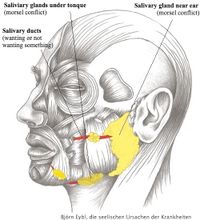Salivary glands
There are several glands in the mouth and pharynx. The largest salivary glands are the parotid glands under the ears, the sublingual glands beneath the tongue, and the submandibular glands beneath the lower jaw. But there are also smaller glands in which programs can run. They all have the same theme and are treated together here.
Also see: mouth submucosa, mouth and pharyngeal surface mucosa, tonsils, salivary ducts.
Themes
- Unable to swallow a (food) morsel due to a lack of saliva (right side), i.e. wanting to swallow something but cannot or should not.
- Not being able to spit out (vomit) a morsel because of a lack of saliva (left side), so getting something you don't want, you want to spit something out, vomit it up.
Difference between left and right see ring shaped organism.
CA phase
Functional increase, increase of cells in the salivary glands.
Biological utility
- To better salivate the morsel to swallow. Result: morsel slips in more easily.
- To better salivate the morsel to spit out. Result: chunk slips out more easily.
Symptoms
Enlargement of salivary gland(s), possibly overproduction of saliva.
PCL phase
Functional normalization. Decomposition of the extra cells by fungi or TB bacteria, if present.
Symptoms
Salivary gland inflammation. Fatigue and/or night sweats, swelling, fever, smelly saliva, foul taste.
EC
Strong pain, chills.
Hanging healing or many relapses: decreasing cells of salivary gland and saliva production, dry, "sticky" mouth, cystic fibrosis, Sjögren's syndrome (see also endoderm).

